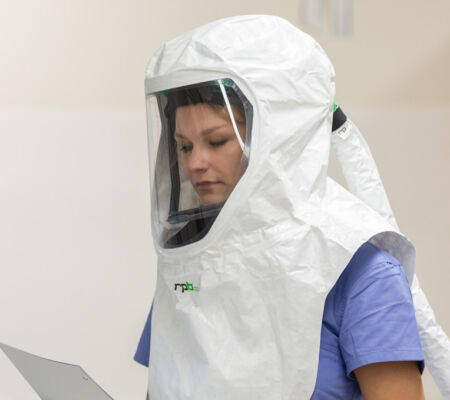
The impact of wearing PPE when caring for patients with Dementia
Back to Articles & Resources View all Healthcare & Life Sciences content
As we find cures for diseases, understand better ways to live healthier lives and through technological advancements in medicines, we are able to receive treatment with higher success rates. Because of this, our life expectancy has increased. Although this is a positive outcome, living for longer exposes us to other diseases that are more prevalent in ageing populations. One of the most common and likely to affect our lives in some way is dementia.
Dementia is an umbrella term that encompasses numerous neurological conditions, such as Alzheimer’s Disease, Lewy Body Dementia, Vascular Dementia, Frontotemporal Dementia, Parkinson’s Disease, and Huntington’s Disease, all of which, are caused by abnormal brain changes. These changes in the brain can cause a range of symptoms that affect people, both cognitively and psychologically. Common cognitive symptoms can include memory loss, difficulty communicating, decreased visual and spatial abilities, decreased problem-solving and/or reasoning ability, difficulty planning and confusion/disorientation. In addition, the onset of these symptoms can be accompanied by psychological changes which can lead to changes in personality, depression, anxiety, inappropriate behavior, paranoia, agitation, and hallucinations.
Globally, there is an estimated 50 million people living with dementia, and this number is anticipated to grow exponentially as life expectancy increases. By 2030, this number is projected to rise to 82 million and by 2050, to 152 million. In the US alone, there is currently 5.7 million people with dementia and by 2050 that is projected to grow to 13.8 million. Right now, it is the 6th leading cause of death in the U.S, claiming the lives of over 120,000 people each year. As population will increase and the number of people suffering from dementia is expected to rise, the number of deaths will rise significantly.
Dementia contributes to the deterioration of many aspects of a person’s life, as the physiological decline impedes their ability to fight off infections. In many cases, an acute illness such as pneumonia can be the cause of death. With the outbreak of COIVD-19 there has been a greater health risk for those with dementia due to their weakened immune system. Additionally, doctors, nurses, and home health aides treating dementia patients have discovered that wearing PPE such as surgical masks and N95 respirators has created a barrier to treatment and exacerbates their patient’s levels of distress. Those with cognitive impairments such as memory loss and confusion struggle to recognize who they are with as the masks/respirators cover up a large portion of the face. The voice can also become muffled when wearing these and this further adds to the patient’s difficulty understanding and reading the situation, creating more anxiety.
This interference with medical personnel’s ability to care and keep patients feeling safe highlights a challenge, but also an opportunity to seek alternative forms of PPE that are better suited to their environment. Perhaps one of the positive results from COVID-19 has been the drastic changes to our thinking in how we approach health and safety in healthcare settings. With worldwide PPE supplies strained and the need for greater levels of protection recognized, this has pushed users to look for different forms of PPE. One that has been utilized and proven to be very successful is many healthcare settings, is a loose-fitting respirator.
Prior to COVID-19, loose-fitting respirators have been largely utilized in industrial and pharmaceutical settings. Their greater level of respiratory protection and ability to add accessories that are suited to their particular application makes them a versatile and favored choice in these settings. Because they are an all-inclusive unit that provides both respiratory and eye protection with a positive pressure filtered air supply, the view of the wearers face is unobstructed as it is only covered by clear plastic. These could be utilized when caring for dementia patients as they can find comfort in seeing the person’s whole face and hearing their voice properly.
As there is going to be a significant increase in the number of people living with dementia and more stringent health and safety requirements for treating people in the wake of COVID-19, it is important to use this opportunity to improve the care that we provide while increasing our own level of protection. By utilizing technology that is reflective of the time, such as loose-fitting respirators, many of the treatment barriers that we currently face can be broken down.
Works Cited
Alzheimer's Association, (n.d.). What is dementia? Retrieved from Alzheimer's Association: https://www.alz.org/alzheimers-dementia/what-is-dementia
ASHA. (n.d.). Dementia . Retrieved from The American Speech-Language-Hearing Association:
https://www.asha.org/PRPSpecificTopic.aspx?folderid=8589935289§ion=Incidence_and_Prevalence
CDC. (2017, March 17). Leading Causes of Death. Retrieved from Centers for Disease Control and Prevention: https://www.cdc.gov/nchs/fastats/leading-causes-of-death.htm
Cherney, K, & J. Herndon. (2019, May 24). Everything You Need to Know About Alzheimer’s Disease. Retrieved from Healthline: https://www.healthline.com/health/alzheimers-disease#facts
Corr, K. (2015, June 26). What is the life expectancy for someone with dementia? Retrieved from Live Better With: https://dementia.livebetterwith.com/blogs/advice/what-is-the-life-expectancy-for-someone-with-dementia
Dementia Australia. (n.d.). The later stages of dementia. Retrieved from Dementia Australia: https://www.dementia.org.au/about-dementia/carers/later-stages-of-dementia
Ellis, M, & Higuera, V. (2018, September 17). 10 Early Symptoms of Dementia. Retrieved from Healthline: https://www.healthline.com/health/dementia/early-warning-signs
Mayo Clinic (2019, April 19). Dementia. Retrieved from Mayo Clinic: https://www.mayoclinic.org/diseases-conditions/dementia/symptoms-causes/syc-20352013
NHS. (2020, March). Impact of PPE on Individuals with Dementia. Retrieved from NHS: https://www.nhsaaa.net/media/8922/8-impact-of-ppe-on-individuals-with-dementia.pdf
